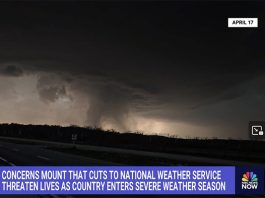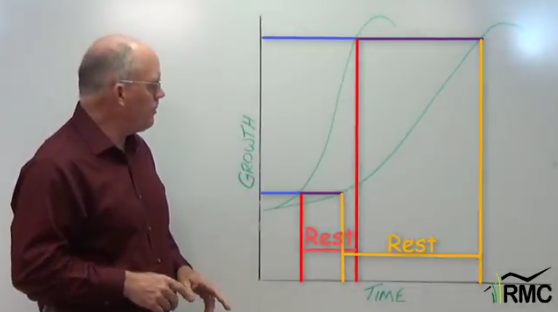
The question “Does Grazing Winter Stockpile Slow Spring Regrowth?” first came up when we were following Troy Bishopp’s progress as he extended his New York grazing season into December. I searched the internet and spoke to a number of folks to find out.
The answer to how much future forage production you’ll get from a grazed plant is no different for grazing stockpile than it is for grazing pasture any other time of the year: “It depends on how much residual you leave.” No matter what time of year you graze, you can reduce a plant’s ability to regrow by grazing off too much so that the plant doesn’t have enough resources to respond.
According to Colorado State University’s M.J. Trlica, removal of dead leaf material and stems during dormancy has little direct effect on the plant. Accordingly he says, “Grazing during the fall and winter periods, after plant growth is complete and plants are dormant, can be much heavier than at other periods of the year. This old material is of little value to the plant, as photosynthetic capability will be low, at best.”
What is Dormant?
Understanding how dormancy works can add to our ability to manage. Victor Shelton, NRCS agronomist/grazing specialist and On Pasture author explains it this way:
“During the growing season, forages use photosynthesis to change carbon dioxide, water and inorganic salts into carbohydrates. The carbohydrates are used by the plant or are stored for winter hibernation. In the fall, forages move these “sugars” down into the roots to provide energy for winter months and spring regrowth. Plants need to go into dormancy to conserve energy and therefore dormancy is a mechanism that is vital to plant survival.
“It usually requires several nights in a row of temperatures of 25 degrees F before plants go dormant. So, in mild winters I actually question if we truly reach full dormancy with a lot of forages. Pasture aspect can affect dormancy as well. Southwest facing slopes tend to be warmer in the winter and are more likely to show weakened dormancy, Occasionally the same thing happens on some sandy soils.”

So, dormancy isn’t some kind of super power, meaning you’ll have to manage your fall pastures just the way you manage them the rest of the year: with care to leave enough behind so the plant can wake up in the spring and start growing at full speed. You need to watch out for too much trampling that can cause injury to crowns of plants, reducing their ability to grow again. In addition, removing too much mulch and litter may cause greater temperature extremes near the soil surface and could adversely affect growth the following year. As Trlica tells us, “Although fall and winter grazing has the least detrimental effect on grasses, there may still be some negative impact if grazing is heavy.”
What About Tillering?
Perennial grasses do most of their reproduction through tillering, and not seed production. Tillers are those parts of the grass plant that are capable of producing another new plant. It makes sense then that you want to manage your grazing so that you don’t damage too many tillers.
How you graze to protect your tillers will depend on where you live. When Troy asked Jim Gerrish, author of “Kick the Hay Habit,” for his input, Jim said:
“In rangeland environments with annual precip less than 15-20 inches grasses only have one spring flush of tillers and then a secondary flush in autumn. In a 30”+ precip environment with grasses like orchard grass fescue, ryegrass, etc., there is ongoing tillering throughout the growing season so the plant is much less dependent on single lead tillers for next spring’s production.”
Those of us in more brittle, arid environments are going to need to be more protective of our tillers. And of course it all depends on the kinds of grasses you have in your pastures as well, as different species have different tillering heights.
But I Just Want an ANSWER!

I agree, it now sounds very complicated when all we really wanted was a single answer. But since we all live in different places and have different management styles, it’s important to have some of this background so we can make good adjustments.
The closest I was able to come to a single answer comes from Sid Bosworth at the University of Vermont in his webinar on “Forage Plant Response to Defoliation.” He recommends letting grasses grow 3 to 4 leaves before beginning to graze them in the winter so that they have adequate energy reserves stored to make it through the winter. Then, if you graze them as stockpile, be sure to leave a 3 to 4 inch residue.
Is this the only right answer? Probably not. Here’s more to add to your thought process:
Stan Boltz is an NRCS Rangeland Management Specialist in South Dakota with 33 years of grazing experience:
This is an interesting question to me. We were taught in the old days that the roots were the grasses’ carbohydrate reserve, which they drew from in the spring to start growth. More recently, plant physiologists have determined that carbohydrates cannot be translocated from the roots to the above-ground plant. And in the spring, only 5-10% of new grass growth is fueled by carbohydrates in the sheaths and the upper root/plant crown at the surface of the ground – the other 90-95% of new grass growth comes from photosynthesis from the new leaves themselves. So protecting the root/plant crown and leaving some sheathes seems to be critical for initiating new plant growth in the spring.
Another aspect is what effect does “trampling” have on grasses during the “dormant” period. I live in a fairly cold region, so after the first couple snowfalls, our snow cover tends to remain through the winter. I made an observation outside of my office last winter. There was a path in the snow that many people took on their way to their vehicles all winter long, and the snow got trampled and packed down on that path. Once the snow melted down to the ground level, people took other paths, because the exposed ground surface became muddy. What was the effect of that winter trampling on the lawn grass, Kentucky bluegrass? I have a picture of when the lawn started growing last spring, and you can easily see where the trampled snow path was.
Richard Sparks is a grazier in Kentucky:
Snow cover has a very dramatic insulating effect on biennial and perennial plants. Compacted snow conducts heat much better; bare ground even more so. Kentucky bluegrass is very sensitive to winter kill when tillers get too cold over winter. “Winterkill” seems to be worse on Kentucky bluegrass, orchard grass, tall fescue, etc. in colder climates. Also, exposure to sunlight can dry the soil out in the spring before temperatures are warm enough to allow tiller growth. A sudden drop in cold temperatures can kill early tillers if they are exposed.
Bob Gillaspy is an NRCS Resource Conservationist specializing in grazing issues:
The keys to success are monitoring (you need to know what to look for) and responding to the results.
The quickest way to grow forage is to have green leaf blades when the weather is good for plant growth. Make it easier on the plant to grow by leaving a few leaf blades on each tiller.
Thinking about it
 There are always sacrifices and ways to mitigate for them. Troy Bishopp has told me that sometimes one of his pastures may get more use and more trampling than he’d like because that’s where the animals walk to water. That means he adjusts use in the spring or summer so that pasture gets the recovery time it needs.
There are always sacrifices and ways to mitigate for them. Troy Bishopp has told me that sometimes one of his pastures may get more use and more trampling than he’d like because that’s where the animals walk to water. That means he adjusts use in the spring or summer so that pasture gets the recovery time it needs.
Maybe the best thing you can do is keep track of how things went with notes on whatever grazing chart you use. Here are the free 2021 versions of the chart you can look at, and then stay tuned for the 2022 versions coming in the spring.
Here are some questions you can ask as you consider this information:
What kinds of grasses am I growing and what do they need to be successful?
Need help with grass ID? Here you go:
Have my grasses gone dormant?
For some help, here’s more on the topic from Victor Shelton.
What are some management techniques I can use to prevent winter overgrazing?




